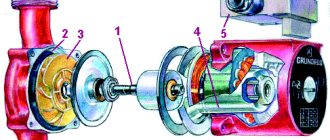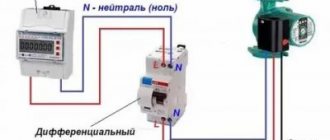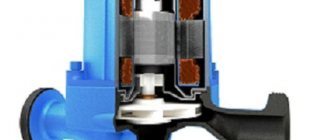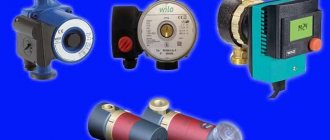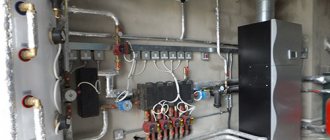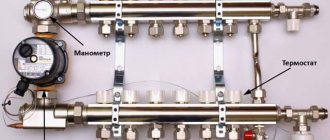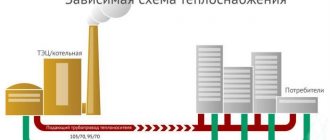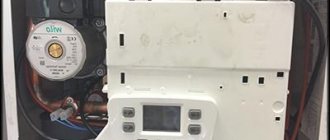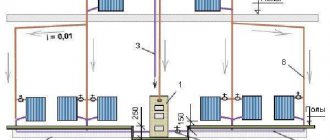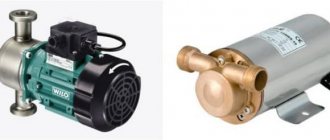How to find out the pump flow rate
The calculation formula looks like this: Q=0.86R/TF-TR
Q – pump flow rate in m.cub./h;
R – thermal power in kW;
TF – coolant temperature in degrees Celsius at the system inlet,
Layout of the heating circulation pump in the system
Three options for calculating thermal power
Difficulties may arise in determining the thermal power index (R), so it is better to focus on generally accepted standards.
Option 1. In European countries it is customary to take into account the following indicators:
- 100 W/sq.m. – for small private houses;
- 70 W/sq.m. – for high-rise buildings;
- 30-50 W/sq.m. – for industrial and well-insulated residential premises.
Option 2. European standards are well suited for regions with mild climates. However, in the northern regions, where there are severe frosts, it is better to focus on the standards of SNiP 2.04.07-86 “Heating networks”, which take into account external temperatures down to -30 degrees Celsius:
- 173-177 W/sq.m. – for small buildings whose number of storeys does not exceed two;
- 97-101 W/sq.m. – for houses of 3-4 floors.
Option 3. Below is a table from which you can independently determine the required thermal power, taking into account the purpose, degree of wear and thermal insulation of the building.
Table: how to determine the required thermal power
Formula and tables for calculating hydraulic resistance
Viscous friction occurs in pipes, shut-off valves and any other components of the heating system, which leads to specific energy losses. This property of systems is called hydraulic resistance. A distinction is made between friction along the length (in pipes) and local hydraulic losses associated with the presence of valves, turns, areas where the diameter of pipes changes, etc. The hydraulic resistance indicator is denoted by the Latin letter “H” and measured in Pa (pascals).
Calculation formula: H=1.3*(R1L1+R2L2+Z1+Z2+….+ZN)/10000
R1, R2 indicate pressure loss (1 – supply, 2 – return) in Pa/m;
L1, L2 – pipeline length (1 – supply, 2 – return) in m;
Z1, Z2, ZN – hydraulic resistance of system components in Pa.
To facilitate calculations of pressure loss (R), you can use a special table that takes into account possible pipe diameters and provides additional information.
Table for determining pressure loss
Averaged data for system elements
The hydraulic resistance of each element of the heating system is given in the technical documentation. Ideally, you should use the specifications specified by the manufacturers. In the absence of product passports, you can rely on approximate data:
- boilers – 1-5 kPa;
- radiators – 0.5 kPa;
- valves – 5-10 kPa;
- mixers – 2-4 kPa;
- heat meters – 15-20 kPa;
- check valves – 5-10 kPa;
- control valves – 10-20 kPa.
Information about the hydraulic resistance of pipes made of various materials can be calculated from the table below.
Pipe pressure loss table
Why do you need a circulation pump?
It is no secret that most consumers of heating services living on the upper floors of high-rise buildings are familiar with the problem of cold radiators. Its cause is the lack of necessary pressure. Because if there is no circulation pump, the coolant moves slowly through the pipeline and, as a result, cools down on the lower floors
That is why it is important to correctly calculate the circulation pump for heating systems
Owners of private households often face a similar situation - in the most remote part of the heating structure, the radiators are much colder than at the starting point. Experts consider the optimal solution in this case to be the installation of a circulation pump, as it looks like in the photo. The fact is that in small houses, heating systems with natural circulation of coolants are quite effective, but even here it would not hurt to think about purchasing a pump, since if you properly configure the operation of this device, heating costs will be reduced.
What is a circulation pump? This is a device consisting of a motor with a rotor immersed in a coolant. The principle of its operation is as follows: by rotating, the rotor forces a liquid heated to a certain temperature to move through the heating system at a given speed, resulting in the creation of the required pressure.
Pumps can operate in different modes. If you set the circulation pump in the heating system to maximum operation, a house that has cooled down in the absence of the owners can be warmed up very quickly. Then consumers, having restored the settings, receive the required amount of heat at minimal cost. Circulating devices come with a “dry” or “wet” rotor. In the first version, it is partially immersed in the liquid, and in the second - completely. They differ from each other in that pumps equipped with a “wet” rotor make less noise during operation.
How to prevent breakdown
To protect equipment from possible malfunctions and replacement of various types of high-cost parts, it is recommended to adhere to the rules for using devices:
- It is not advisable to turn on the equipment if for some reason there is no coolant. When there is no water in the pipes, you should not “force” the device to work. Otherwise, you will cause serious damage that cannot be fixed.
- It is recommended to always maintain the required level of coolant water in the pipes. If there is a shortage of water, both with a large amount and with a shortage, the pump will function under wear and tear.
- The pump should not be allowed to remain idle for a long time without any processes in the heating system. It is necessary to run the unit once a month for a while. Elements that move during the process of pumping water can oxidize.
- The water temperature should not reach 65 degrees. A higher rate negatively affects all parts of the structure. Keep an eye on the housing so that it does not leak.
You should repair or replace items yourself after the warranty becomes void. Or in the case when it is not possible to contact the service. Because under warranty you can replace the device if the malfunction is not due to the user’s fault. Parts for many heating system models cannot be found on the Internet, so sometimes it is more economical to buy new equipment than to look for parts for the old one.
Nominal head
Pressure is the difference between the specific energies of water at the outlet of the unit and at the entrance to it.
The pressure happens:
- Volume;
- Mass;
- Weight.
Before buying a pump, you should ask the seller everything about the warranty
. Weight matters in conditions of a certain and constant gravitational field. It increases as the acceleration due to gravity decreases, and when weightlessness is present, it is equal to infinity. Therefore, the weight pressure, which is actively used today, is inconvenient for the characteristics of pumps for aircraft and space objects.
Full power will be used to start. It is supplied externally as the drive energy of an electric motor or with the flow of water, which is supplied to the jet apparatus under a special pressure.
Adjusting circulation pump speeds
Most circulation pump models have a function for adjusting the speed of the device. As a rule, these are three-speed devices that allow you to control the amount of heat that is sent to heat the room. In the event of a sharp cold snap, the operating speed of the device is increased, and when it warms up, it is reduced, despite the fact that the temperature in the rooms remains comfortable for staying in the house.
To change the speed, there is a special lever located on the pump body. Models of circulation devices with an automatic control system for this parameter depending on the temperature outside the building are in great demand.
Recommendations for installation in a heating system
Regardless of the type of design of the circulation pump, it is mounted on the pipeline. Thus, it is easy to dismantle in case of replacement of the device.
Pump installation rules:
- The equipment can be installed in any part of the pipeline; the inclination can be horizontal or vertical. The main thing is that the axis of the router is horizontal.
- A plastic container equipped with electrical contacts is placed on top of the housing, otherwise it will be flooded with coolant in the event of an accident. Moreover, it will complicate the installation and maintenance of the device. Unscrew the screws that secure the box and turn it in the desired direction.
- Observe the direction of water flow through the heating system. The arrow on the body indicates this indicator.
- Shut-off valves will help prevent water from draining. It is recommended to install them on both sides.
It is advisable to purchase shut-off equipment with good mechanical strength. Since the entire load of the circulation pump falls on one or two ball valves, it is better not to skimp on structural elements.
Selection of a circulation pump for a heating system criteria
When choosing a circulation pump for the heating system of a private home, they almost always give preference to models with a wet rotor, specially designed for operation in any household lines of varying lengths and supply volumes.
These devices have the following advantages compared to other types:
- low noise level,
- small overall dimensions,
- manual and automatic adjustment of the number of shaft revolutions per minute,
- pressure and volume indicators,
- suitable for all heating systems of individual houses.
Pump selection by number of speeds
To increase operating efficiency and save energy resources, it is better to take models with stepwise (from 2 to 4 speeds) or automatic control of the electric motor speed.
If automation is used to control the frequency, then energy savings compared to standard models reach 50%, which is about 8% of the electricity consumption of the entire house.
Rice. 8 The difference between a fake (right) and an original (left)
What else to pay attention to
When purchasing popular Grundfos and Wilo models, there is a high probability of counterfeiting, so you should know some of the differences between the originals and their Chinese counterparts. For example, German Wilo can be distinguished from a Chinese counterfeit by the following characteristics:
- The original sample is slightly larger in size and has a serial number stamped on its top cover.
- A raised arrow in the direction of fluid movement in the original was placed on the inlet pipe.
- The de-airing valve on the fake is yellow in brass color (the same color in the Grundfos analogues)
- The Chinese analogue has a bright shiny sticker on the reverse side indicating energy saving classes.
Rice. 9 Criteria for selecting a circulation pump for heating
Recommendations for choosing a pump
A circulation pump installed in the heating system of a private house must perform its basic functions well. Each such device has certain requirements.
- The unit must have the required productivity or performance. This parameter is calculated under conditions of minimal load on the device.
- Another selection criterion is the pressure that provides the required pressure in the pipes and the entire system. In this case, the operating conditions must be taken into account. They depend on the volume of the premises, the type of liquid in the system, the ambient temperature and the coolant itself. The diameter of the pipes used is of great importance.
- When purchasing, you must take into account external factors related to the size of the unit, the noise level during operation, and the difficulties of maintenance.
How to choose and buy a circulation pump
Circulation pumps face somewhat specific tasks, different from water pumps, well pumps, drainage pumps, etc. If the latter are designed to move liquid with a specific outlet point, then circulation and recirculation pumps simply “drive” the liquid in a circle.
I would like to approach the selection in a somewhat non-trivial way and offer several options. So to speak, from simple to complex - start with the manufacturers’ recommendations and lastly describe how to calculate a circulation pump for heating using formulas.
Select a circulation pump
This simple way to select a circulation pump for heating was recommended by one of the WILO pump sales managers.
It is assumed that the heat loss of the room per 1 sq. m. will be 100 W. Formula for calculating consumption:
Total heat loss of the house (kW) x 0.044 = circulation pump flow rate (m3/hour)
For example, if the area of a private house is 800 sq. m. the required flow rate will be:
(800 x 100) / 1000 = 80 kW - heat loss at home
80 x 0.044 = 3.52 cubic meters per hour - the required flow rate of the circulation pump at a room temperature of 20 degrees. WITH.
From the WILO range, the TOP-RL 25/7.5, STAR-RS 25/7, STAR-RS 25/8 pumps are suitable for such requirements.
Regarding the pressure. If the system is designed in accordance with modern requirements (plastic pipes, closed heating system) and there are no non-standard solutions, such as high floors or long heating pipelines, then the pressure of the above pumps should be sufficient.
Again, this selection of a circulation pump is approximate, although in most cases it will satisfy the required parameters.
Select a circulation pump using the formulas.
If you want to understand the required parameters and select it using formulas before buying a circulation pump, then the following information will be useful.
determine the required pump pressure
H=(R x L xk) / 100, where
H—required pump head, m
L is the length of the pipeline between the most distant points “there” and “back”. In other words, this is the length of the largest “ring” from the circulation pump in the heating system. (m)
An example of calculating a circulation pump using formulas
There is a three-story house measuring 12m x 15m. Floor height is 3 m. The house is heated by radiators (∆ T=20°C) with thermostatic heads. Let's make the calculation:
required thermal power
N (from pl.) = 0.1 (kW/sq.m.) x 12 (m) x 15 (m) x 3 floors = 54 kW
calculate the flow rate of the circulation pump
Q = (0.86 x 54) / 20 = 2.33 m3/hour
calculate the pump pressure
The manufacturer of plastic pipes, TECE, recommends using pipes with a diameter at which the fluid flow speed will be 0.55-0.75 m/s, the resistivity of the pipe wall will be 100-250 Pa/m. In our case, a pipe with a diameter of 40mm (11/4″) can be used for the heating system. At a flow rate of 2.319 m3/hour, the coolant flow rate will be 0.75 m/s, the resistivity of one meter of pipe wall will be 181 Pa/m (0.02 mWG).
WILO YONOS PICO 25/1-8
GRUNDFOS UPS 25-70
Almost all manufacturers, including such “giants” as WILO and GRUNDFOS, post special programs for selecting a circulation pump on their websites. For the above-mentioned companies these are WILO SELECT and GRUNDFOS WebCam.
The programs are very convenient, they are quite easy to use
Particular attention should be paid to the correct entry of values, which often causes difficulties for untrained users
Buy a circulation pump
When purchasing a circulation pump, special attention should be paid to the selling company. There are currently a lot of counterfeit products on the Ukrainian market.
How can we explain that the retail price of a circulation pump on the market can be 3-4 times less than that of a representative of the manufacturer?
According to analysts, the circulation pump in the household sector is the leader in energy consumption. In recent years, companies have been offering very interesting new products - energy-saving circulation pumps with automatic power control. From the household series, WILO has YONOS PICO, GRUNDFOS has ALFA2. Such pumps consume several orders of magnitude less electricity and significantly save owners’ financial expenses.
How to choose a heating pump
In stores, the range of pumps for heating systems is so wide that choosing a circulation pump can take a long time. What to choose, how not to make a mistake?
First of all, you need to know the characteristics of the heating system that will be installed in your home (or is already in operation): the power of the boiler, the diameter of the pipelines (where the pump will be installed), the area of the house, the characteristics of the radiators, the type of coolant (water, propylene glycol, ethylene glycol, etc. ). Knowing these parameters, it is easy to calculate the required pump performance using the formula (given below). And knowing the diameter of the pipeline will help you choose the appropriate pump model (inch, one and a half inches, two inches, etc.).
The performance of the circulation pump can be calculated using the formula:
Q = P / (t2 - t1), where:
- Q - coolant flow (pump performance at minimum load);
- P—boiler power, kW;
- t1— coolant temperature in the return pipe (50-60°C);
- t2—temperature of the coolant in the supply pipe (80-90°C).
For example, for a boiler with a power of 24 kW, with a temperature difference of 20 ° C (the norm for a radiator heating system), a pump is suitable: 24/(80-60) = 1.2 m3/hour.
The lifting height of the pump depends on the number of storeys of the cottage, for example, for a one-story house a circulation pump with index 40 is suitable, and for a two or three-story house it is better to take a pump with index 80. The index indicates the pressure (height of water rise): 4 meters for pumps with index 40 and 8 meters - with index 80.
With horizontal wiring, it is generally accepted that to overcome the hydraulic resistance of every 10 meters of the heating system, 0.6 meters of pump pressure is required. Thus, a pump marked 25/40 is capable of pumping about 70 meters of heating system pipes. The number 25 in the pump marking indicates the diameter of the pipe being connected - in this case, 1″ (one inch, 25 mm).
The Wester circulation pump is not installed correctly into the existing heating system; the nominal diameter of the pump clearly does not correspond to the diameter of the pipeline. Photo: teplo112.ru
When choosing a pump for heating, you should not pay attention to the direction of rotation of the rotor and the direction of the flow of the medium - the pump can be built into the system in any case, and the direction of rotation is necessary to control the operation of the pump and to manually rotate the electric motor after a long stay. Having figured out the performance and pressure of the pump, you should pay attention to the nominal diameter of the pump and in no case take a pump with a diameter smaller than the pipes in your heating system
If the pipes are inch - take a circulation pump with index 25, if the pipes are an inch and a quarter - 32, etc. You should not make the pump the bottleneck of the system - this is bad for the pump
Having figured out the performance and pressure of the pump, you should pay attention to the nominal diameter of the pump and under no circumstances choose a pump with a diameter smaller than the pipes in your heating system. If the pipes are inch - take a circulation pump with index 25, if the pipes are an inch and a quarter - 32, etc.
You should not make the pump the bottleneck of the system - this is bad for the pump.
As for the manufacturer's brand and pump brand, you should choose based on reviews on the Internet and by touch, trusting your intuition, because the number of counterfeits of famous companies is simply off the charts.
Most often you will be offered pumps from Grundfos, Wilo, Speroni and others. Grundfos and Vilo are clearly more expensive than the others, but the fame of their “indestructibility” is also strong - they are reliable, silent and economical. Chinese pumps for heating systems are also bought, but about 2 times more often than famous ones, confirming the proverb that “the miser pays twice.”
On the other hand, there are many nuances in the operation of the pump that are usually not omitted during the purchase process, such as the cleanliness of the heating system and the type of coolant. If the heating system is regularly flushed of sludge and soft water is used as a coolant, then under these conditions the Chinese Oasis pump will work for many years. The choice is yours, but don’t be overly deluded by the “indestructibility” of the equipment.
Class! Send Send
Checking the selected electric motor a. Checking the rudder shift duration
For the selected pump, look at the graphs of the dependence of the mechanical and volumetric efficiency on the pressure created by the pump (see Fig. 3).
4.1. We find the moments arising on the electric motor shaft at different steering angles:
,
where: M
α – torque on the electric motor shaft (Nm);
Q
mouth – set pump capacity;
P
α – oil pressure created by the pump (Pa);
P
tr – pressure loss due to oil friction in the pipeline (3.4÷4.0)·105 Pa;
n
n – pump speed (rpm);
η
r – hydraulic efficiency associated with fluid friction in the working cavities of the pump (for rotary pumps ≈ 1);
η
mech - mechanical efficiency, taking into account friction losses (in oil seals, bearings and other rubbing parts of pumps (see graph in Fig. 3).
We enter the calculation data in Table 4.
4.2. We find the rotation speed of the electric motor for the obtained torque values (based on the constructed mechanical characteristics of the selected electric motor - see paragraph 3.6). We enter the calculation data in Table 5.
Table 5
| α° | n, rpm | ηr | Qα, m3/s |
| 5 | |||
| 10 | |||
| 15 | |||
| 20 | |||
| 25 | |||
| 30 | |||
| 35 |
4.3. We find the actual pump performance at the obtained electric motor speeds
,
where: Q
α – actual pump performance (m3/sec);
Q
mouth – installed pump capacity (m3/sec);
n
– actual speed of rotation of the pump rotor (rpm);
n
n – nominal speed of rotation of the pump rotor;
η
v – volumetric efficiency, taking into account the reverse bypass of the pumped liquid (see graph 4.)
We enter the calculation data in table 5. We build a graph Q
α
= f ( α )
– see fig.
4 .
Rice. 4. Graph Q
α
= f ( α )
4.4. We divide the resulting graph into 4 zones and determine the operating time of the electric drive in each of them. We summarize the calculation in Table 6.
Table 6
| Zone | Zone boundary angles α° | Hi (m) | Vi (m3) | Qav.z (m3/sec) | ti (sec) |
| I | |||||
| II | |||||
| III | |||||
| IV |
4.4.1. Find the distance covered by the rolling pins within the zone
,
where: H i
– distance covered by rolling pins within the zone (m);
R o
– distance between the axes of the stock and rolling pins (m).
4.4.2. Finding the volume of oil pumped within the zone
,
where: V i
– volume of pumped oil within the zone (m3);
m
cyl – number of pairs of cylinders;
D
– plunger (rolling pin) diameter, m.
4.4.3. Find the duration of the rudder shift within the zone
,
where: t i
– average duration of rudder shift within the zone (sec);
Q
av
i
– average productivity within the zone (m3/sec) – taken from the graph in clause 4.4. or calculate from table 5).
4.4.4. We determine the operating time of the electric drive when shifting the steering wheel from side to side
t
lane
= t 1 + t 2 + t 3 + t 4 + t o
,
where: t
per – time of shifting the rudder from side to side (sec);
t 1 ÷ t 4
– duration of transfer in each zone (sec);
t o
– time to prepare the system for action (sec).
4.5. We compare t shift with T (time of shifting the rudder from side to side at the request of RRR), sec.
t
lane
≤ T
(30 sec)
Feeding performance of pumping equipment
This is one of the main factors to consider when choosing a device. Supply – the amount of coolant pumped per unit of time (m3/hour). The higher the flow, the greater the volume of liquid that the pump can pump. This indicator reflects the volume of coolant that transfers heat from the boiler to the radiators. If the supply is low, the radiators will not heat well. If the performance is excessive, home heating costs will increase significantly.
The power of circulation pumping equipment for a heating system can be calculated using the following formula: Qpu=Qn/1.163xDt [m3/h]
In this case, Qpu is the supply of the unit at the design point (measured in m3/hour), Qn is the amount of heat consumed in the area that is heated (kW), Dt is the temperature difference recorded on the forward and return pipelines (for standard systems this is 10- 20°C), 1.163 – indicator of the specific heat capacity of water (if another coolant is used, the formula must be adjusted).
How to determine the required pressure of the circulation pump
The head of centrifugal pumps is most often expressed in meters. The pressure value allows you to determine what hydraulic resistance it can overcome. In a closed heating system, the pressure does not depend on its height, but is determined by hydraulic resistance. To determine the required pressure, it is necessary to perform a hydraulic calculation of the system. In private homes, when using standard pipelines, as a rule, a pump that develops a pressure of up to 6 meters is sufficient.
You should not be afraid that the selected pump is capable of developing greater pressure than you need, since the developed pressure is determined by the resistance of the system, and not by the number indicated in the passport. If the maximum pressure of the pump is not enough to pump liquid through the entire system, there will be no circulation of liquid, so you should choose a pump with a headroom reserve
.
How to choose a circulation pump based on the data received
Having completed the calculations and determined the main parameters (flow and pressure), we will proceed to selecting a suitable circulation pump. To do this, we use graphs of their technical characteristics (B), which can be found in the passport or operating instructions. Such a graph should have two axes with pressure values (usually in m) and flow (productivity) in m3/h, l/h or l/s. We plot the data obtained during the calculation on this graph in the appropriate dimension and at their intersection we find point (A). If it is above the pump characteristic graph (A3), then this model is not suitable for us. If the point falls on the chart (A2) or is below it (A1), then this is a suitable option. But it is necessary to take into account that if the point is located significantly below the graph (A1), this means that the pump will have an excessive power reserve, which is also impractical, since it will consume more electricity and its cost will also be higher than the model, characteristics graph which will be as close as possible to our point.
There are pump models that have not one, but 2-3 speeds. The graphs of their characteristics will have not one, but, accordingly, 2 or 3 lines. In this case, the selection of the pump must be done according to the schedule of the speed that will be used or taking into account all lines if all speeds will be used.
